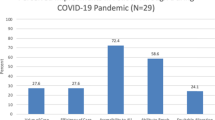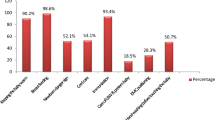Abstract
Objective:
High-risk infant follow-up programs have the potential to act as multipurpose clinics by providing continuity of clinical care, education of health care trainees and facilitating outcome data research. Currently there are no nationally representative data on high-risk infant follow-up practices in the United States. The objective of this study is to collect information about the composition of high-risk infant follow-up programs associated with academic centers in the United States, with respect to their structure, function, funding resources and developmental assessment practices, and to identify the barriers to establishment of such programs.
Study Design:
Staff neonatologists, follow-up program directors and division directors of 170 Neonatal Intensive Care Units (NICU) associated with pediatric residency programs were invited to participate in an anonymous online survey from October 2009 to January 2010.
Result:
The overall response rate was 84%. Ninety three percent of the respondents have a follow-up program associated with their NICU. Birth weight, gestational age and critical illness in the NICU were the major criteria for follow-up care. Management of nutrition and neurodevelopmental assessments was the most common service provided. Over 70% have health care trainees in the clinic. About 75% of the respondents have the neurodevelopmental outcome data available. Most of the respondents reported multiple funding sources. Lack of personnel and funding were the most common causes for not having a follow-up program.
Conclusion:
High-risk infant follow-up programs associated with academic centers in the United States are functioning as multidisciplinary programs providing clinical care, trainee education and facilitating outcomes research.
This is a preview of subscription content, access via your institution
Access options
Subscribe to this journal
Receive 12 print issues and online access
$259.00 per year
only $21.58 per issue
Buy this article
- Purchase on Springer Link
- Instant access to full article PDF
Prices may be subject to local taxes which are calculated during checkout

Similar content being viewed by others
References
Vohr BR, O’Shea M, Wright LL . Longitudinal multicenter follow-up of high-risk infants: why, who, when, and what to assess. Semin Perinatol 2003; 27: 333–342.
Fanaroff AA, Hack M, Walsh MC . The NICHD neonatal research network: changes in practice and outcomes during the first 15 years. Semin Perinatol 2003; 27: 281–287.
American Academy of Pediatrics Committee on Fetus and Newborn. Policy Statement. Hospital discharge of the high-risk neonate. Pediatrics 2008; 122: 1119–1126.
Vohr B, Wright L, Hack M, Aylward G, Hirtz D . Follow-up care of high risk infants. Pediatrics 2004; 114: 1377–1397.
Verma RP, Sridhar S, Spitzer AR . Continuing care of NICU graduates. Clin Pediatr (Phila) 2003; 42: 299–315.
Freed GL, Dunham KM, Switalski KE, Jones Jr MD, McGuinness GA . Recently trained general pediatricians: perspectives on residency training and scope of practice. Pediatrics 2009; 123 (Suppl 1): S38–S43.
Adams K, Corrigan JM eds, Priority Areas for National Action— Transforming Health Care Quality. The National Academies Press: Washington, DC, 2003.
Lantos J . Cruel calculus: why saving premature babies is better business than helping them thrive. Health Aff (Millwood) 2010; 29: 2114–2117.
Berman S, Rannie M, Moore L, Elias E, Dryer LJ, Jones Jr MD . Utilization and costs for children who have special health care needs and are enrolled in a hospital-based comprehensive primary care clinic. Pediatrics 2005; 115: e637–e642.
Russell RB, Green NS, Steiner CA, Meikle S, Howse JL, Poschman K et al. Cost of hospitalization for preterm and low birth weight infants in the United States. Pediatrics 2007; 120: e1–e9.
Rogowski J . Measuring the cost of neonatal and perinatal care. Pediatrics 1999; 103 (1 Suppl E): 329–335.
Gilbert WM, Nesbitt TS, Danielson B . The cost of prematurity: quantification by gestational age and birth weight. Obstet Gynecol 2003; 102: 488–492.
Cavalier S, Escobar GJ, Fernbach SA, Quesenberry Jr CP, Chellino M . Postdischarge utilization of medical services by high-risk infants: experience in a large managed care organization. Pediatrics 1996; 97: 693–699.
Brooten D, Kumar S, Brown LP, Butts P, Finkler SA, Bakewell-Sachs S et al. A randomized clinical trial of early hospital discharge and home follow-up of very-low-birth-weight infants. N Engl J Med 1986; 315: 934–939.
Kotagal UR, Perlstein PH, Gamblian V, Donovan EF, Atherton HD . Description and evaluation of a program for the early discharge of infants from a neonatal intensive care unit. J Pediatr 1995; 127: 285–290.
Spinner SS, Girifalco RB, Gibson E, Stavis RL, Greenspan JS, Spitzer AR . Earlier discharge of infants from neonatal intensive care units: a pilot program of specialized case management and home care. Delaware Valley Child Health Alliance. Clin Pediatr (Phila) 1998; 37: 353–357.
Broyles RS, Tyson JE, Heyne ET, Heyne RJ, Hickman JF, Swint M et al. Comprehensive follow-up care and life-threatening illnesses among high-risk infants: a randomized controlled trial. JAMA 2001; 284: 2070–2076.
Martin JA, Menacker F . Expanded health data from the new birth certificate, 2004. Natl Vital Stat Rep 2007; 55: 1–22.
Author information
Authors and Affiliations
Corresponding author
Ethics declarations
Competing interests
The authors declare no conflict of interest.
Additional information
Author contribution
VSK designed and distributed the survey, obtained and interpreted the results and drafted the manuscript. MT provided statistical analysis and interpretation of the data. BH provided intellectual input into the survey design and critically reviewed the manuscript. JS conceived the idea and provided mentorship to first author. KY provided intellectual input into the survey design, manuscript drafting and approved the final version to be published.
Rights and permissions
About this article
Cite this article
Kuppala, V., Tabangin, M., Haberman, B. et al. Current state of high-risk infant follow-up care in the United States: results of a national survey of academic follow-up programs. J Perinatol 32, 293–298 (2012). https://doi.org/10.1038/jp.2011.97
Received:
Revised:
Accepted:
Published:
Issue Date:
DOI: https://doi.org/10.1038/jp.2011.97
Keywords
This article is cited by
-
Identifying barriers and facilitators to care for infants with bronchopulmonary dysplasia after NICU discharge: a prospective study of parents and clinical stakeholders
Journal of Perinatology (2024)
-
Race, language, and neighborhood predict high-risk preterm Infant Follow Up Program participation
Journal of Perinatology (2022)
-
Follow-through care for high-risk infants during the COVID-19 pandemic: lessons learned from the Vermont Oxford Network
Journal of Perinatology (2021)
-
Telemedicine, a tool for follow-up of infants discharged from the NICU? Experience from a pilot project
Journal of Perinatology (2020)
-
The acceptability and feasibility of emailed parent questionnaires for medical and developmental surveillance after NICU discharge
Journal of Perinatology (2018)



